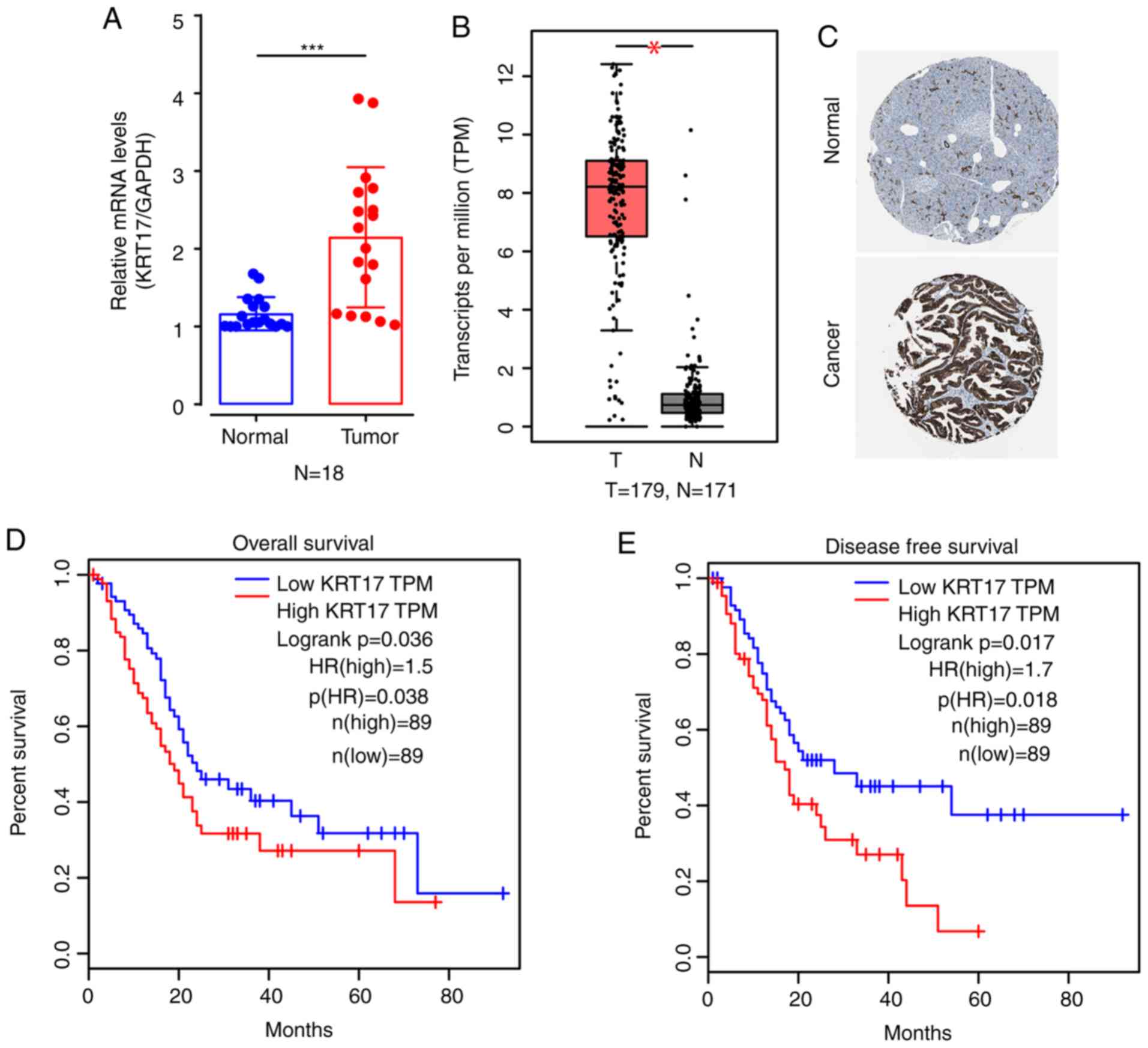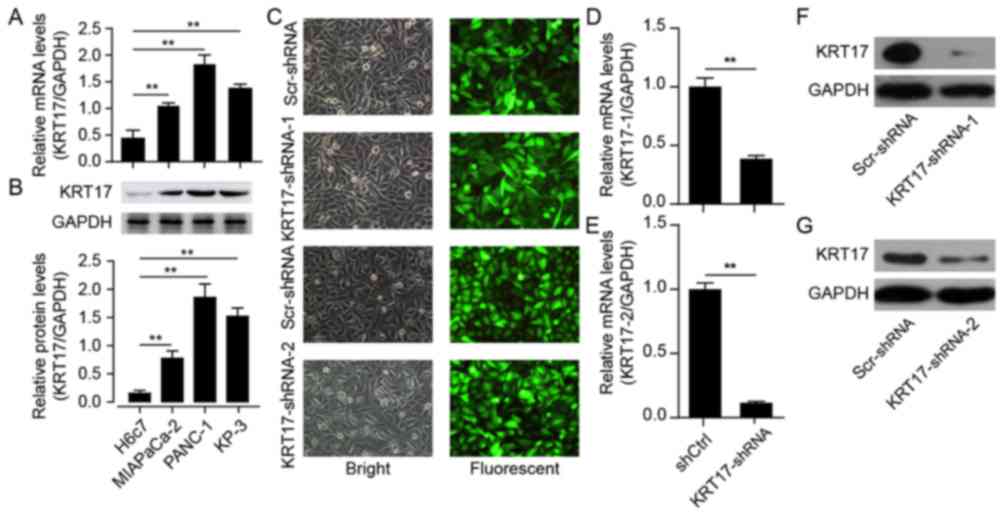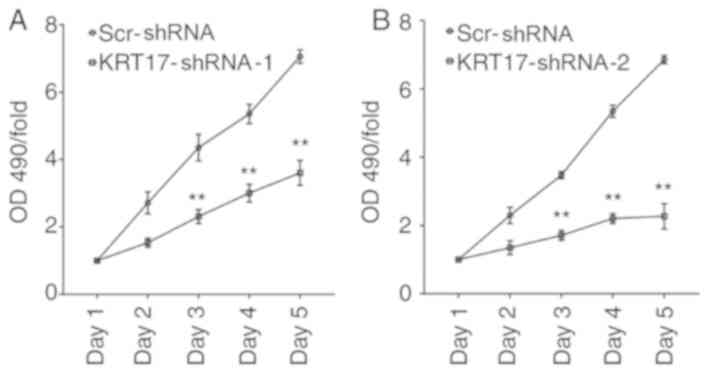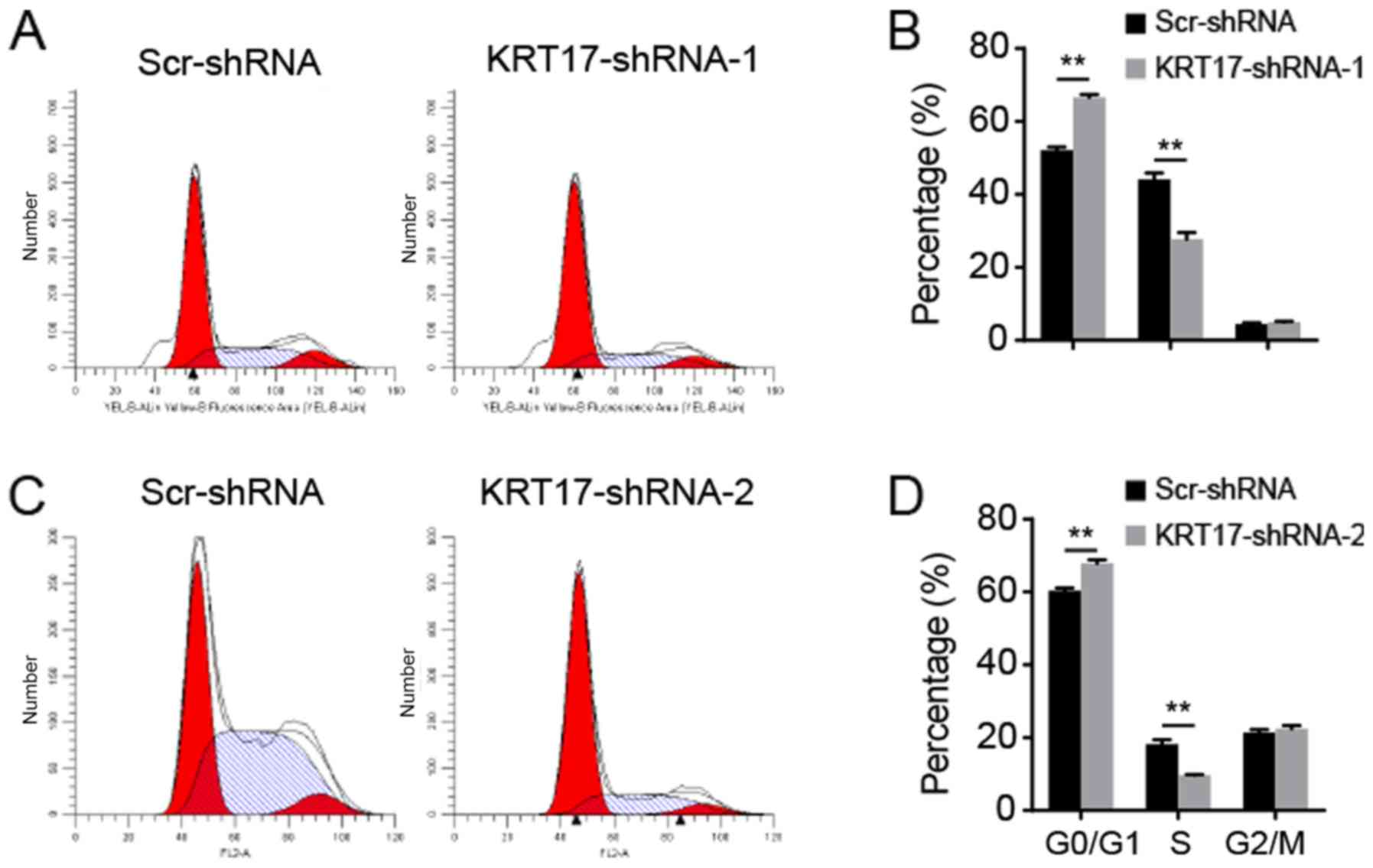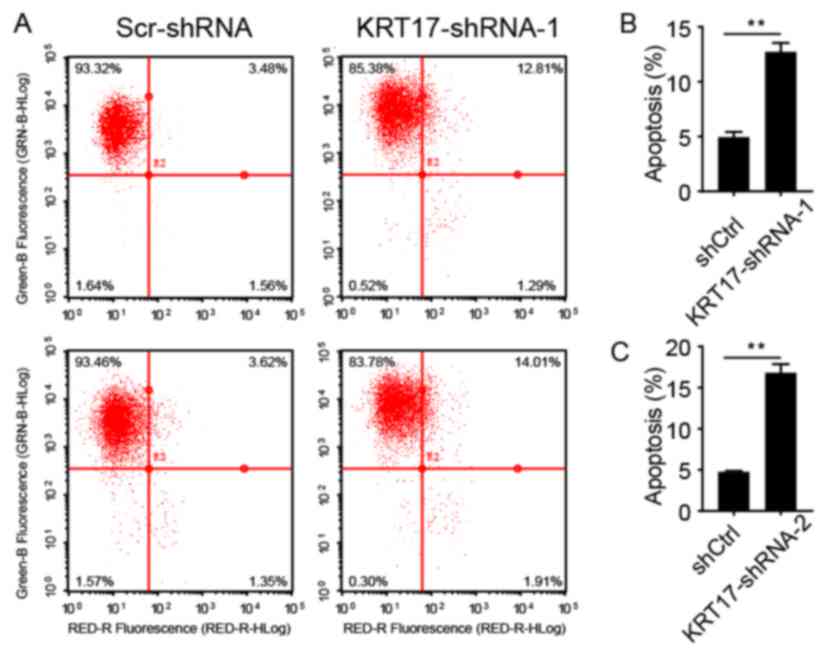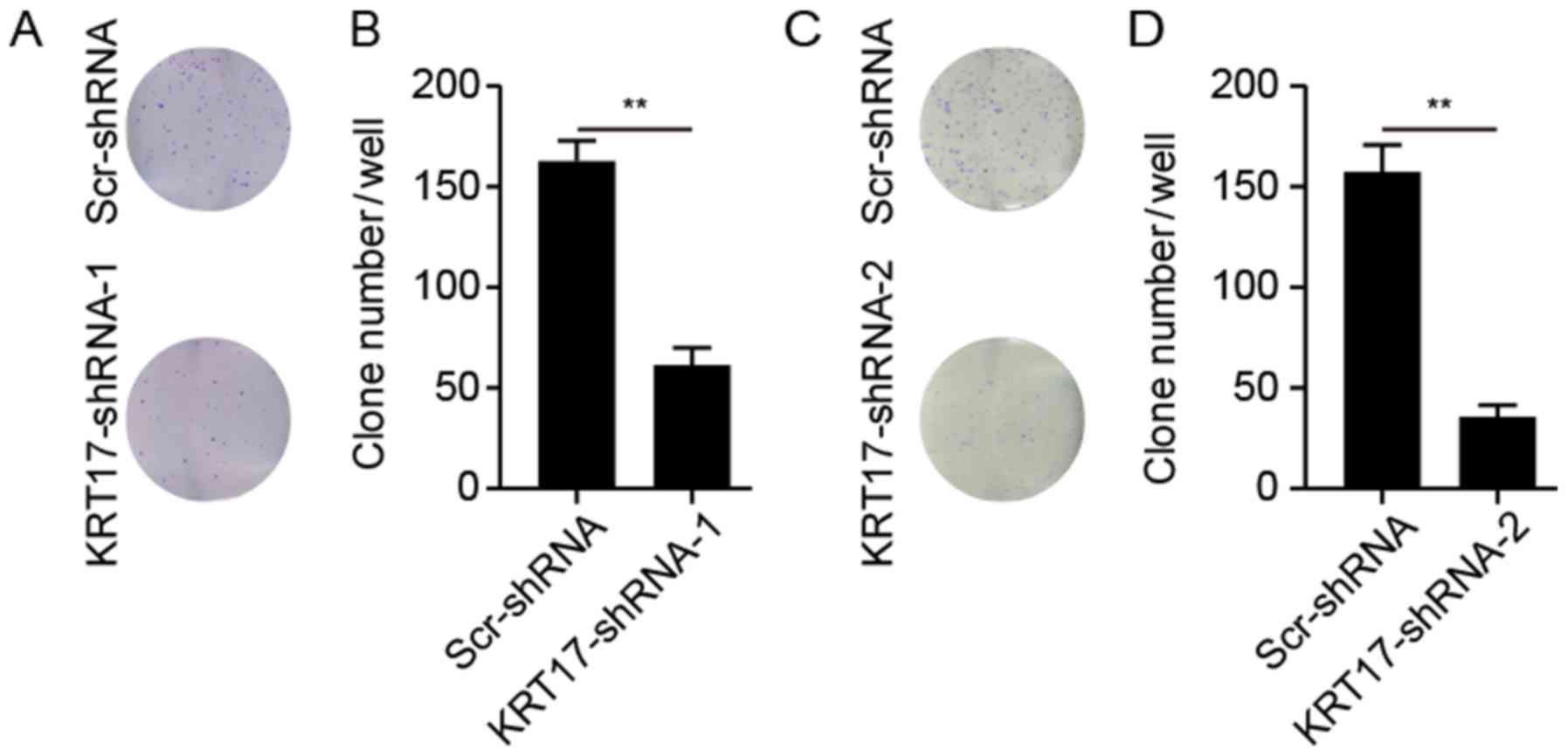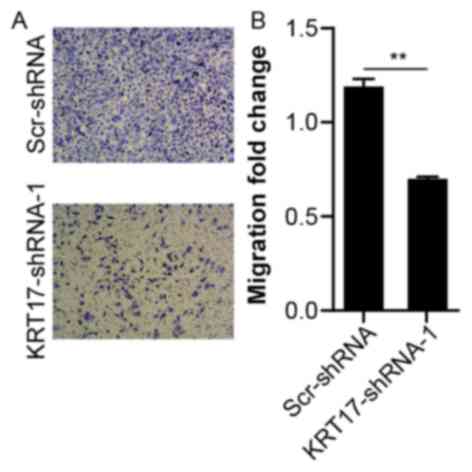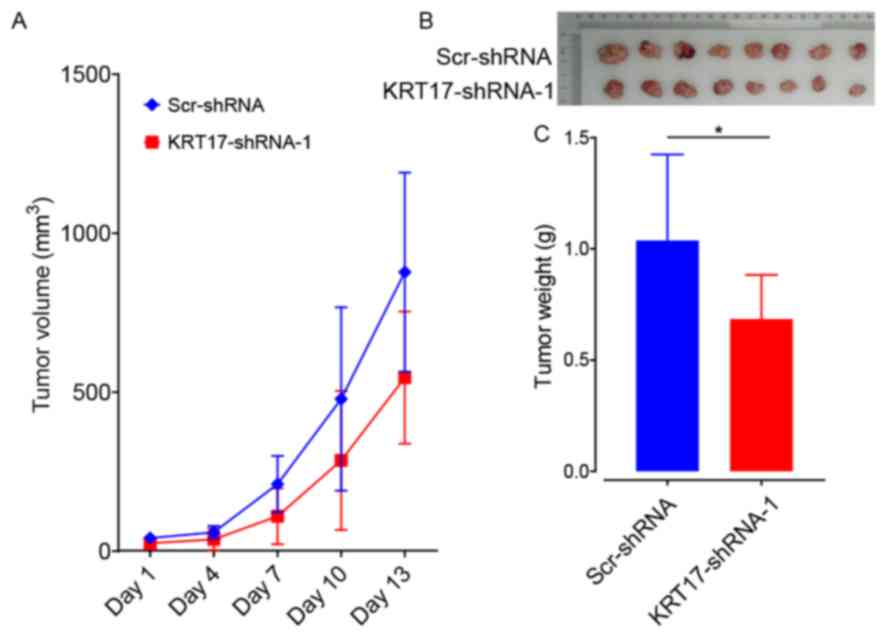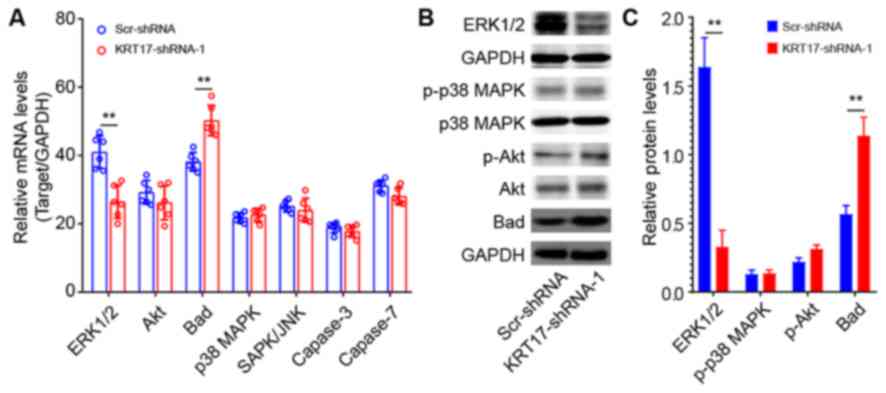|
1
|
Saad AM, Turk T, Al-Husseini MJ and
Abdel-Rahman O: Trends in pancreatic adenocarcinoma incidence and
mortality in the United States in the last four decades; a
SEER-based study. BMC Cancer. 18:6882018. View Article : Google Scholar : PubMed/NCBI
|
|
2
|
Hu D, Ansari D, Zhou Q, Sasor A, Said
Hilmersson K and Andersson R: Galectin 4 is a biomarker for early
recurrence and death after surgical resection for pancreatic ductal
adenocarcinoma. Scand J Gastroenterol. 54:95–100. 2019. View Article : Google Scholar : PubMed/NCBI
|
|
3
|
Vincent A, Herman J, Schulick R, Hruban RH
and Goggins M: Pancreatic cancer. Lancet. 378:607–620. 2011.
View Article : Google Scholar : PubMed/NCBI
|
|
4
|
Falasca M, Kim M and Casari I: Pancreatic
cancer: Current research and future directions. Biochim Biophys
Acta. 1865:123–132. 2016.PubMed/NCBI
|
|
5
|
van den Hurk R, Dijkstra G, van Mil FN,
Hulshof SC and van den Ingh TS: Distribution of the intermediate
filament proteins vimentin, keratin, and desmin in the bovine
ovary. Mol Reprod Dev. 41:459–467. 1995. View Article : Google Scholar : PubMed/NCBI
|
|
6
|
Somji S, Cao L, Mehus A, Zhou XD, Sens MA,
Dunlevy JR, Garrett SH, Zheng Y, Larson JL and Sens DA: Comparison
of expression patterns of keratin 6, 7, 16, 17, and 19 within
multiple independent isolates of As(+3)- and Cd (+2)-induced
bladder cancer: Keratin 6, 7, 16, 17, and 19 in bladder cancer.
Cell Biol Toxicol. 27:381–396. 2011. View Article : Google Scholar : PubMed/NCBI
|
|
7
|
Jacob JT, Coulombe PA, Kwan R and Omary
MB: Types I and II keratin intermediate filaments. Cold Spring Harb
Perspect Biol. 10(pii): a0182752018. View Article : Google Scholar : PubMed/NCBI
|
|
8
|
Herrmann H and Aebi U: Intermediate
filaments: Molecular structure, assembly mechanism, and integration
into functionally distinct intracellular Scaffolds. Annu Rev
Biochem. 73:749–789. 2004. View Article : Google Scholar : PubMed/NCBI
|
|
9
|
Herrmann H and Aebi U: Intermediate
filaments: Structure and assembly. Cold Spring Harb Perspect Biol.
8(pii): a0182422016. View Article : Google Scholar : PubMed/NCBI
|
|
10
|
Kurokawa I, Takahashi K, Moll I and Moll
R: Expression of keratins in cutaneous epithelial tumors and
related disorders-distribution and clinical significance. Exp
Dermatol. 20:217–228. 2011. View Article : Google Scholar : PubMed/NCBI
|
|
11
|
Kim S, Wong P and Coulombe PA: A keratin
cytoskeletal protein regulates protein synthesis and epithelial
cell growth. Nature. 441:362–365. 2006. View Article : Google Scholar : PubMed/NCBI
|
|
12
|
Proby CM, Churchill L, Purkis PE, Glover
MT, Sexton CJ and Leigh IM: Keratin 17 expression as a marker for
epithelial transformation in viral warts. Am J Pathol.
143:1667–1678. 1993.PubMed/NCBI
|
|
13
|
Shi X, Jin L, Dang E, Chang T, Feng Z, Liu
Y and Wang G: IL-17A upregulates keratin 17 expression in
keratinocytes through STAT1- and STAT3-dependent mechanisms. J
Invest Dermatol. 131:2401–2408. 2011. View Article : Google Scholar : PubMed/NCBI
|
|
14
|
Zhang W, Dang E, Shi X, Jin L, Feng Z, Hu
L, Wu Y and Wang G: The pro-inflammatory cytokine IL-22
up-regulates keratin 17 expression in keratinocytes via STAT3 and
ERK1/2. PLoS One. 7:e407972012. View Article : Google Scholar : PubMed/NCBI
|
|
15
|
Yang L, Zhang S and Wang G: Keratin 17 in
disease pathogenesis: From cancer to dermatoses. J Pathol.
247:158–165. 2019.PubMed/NCBI
|
|
16
|
Ghazawi FM, Hassani-Ardakani K, Henriques
L and Jafarian F: Identification of a novel substitution mutation
(R103C) in the rod domain of the keratin 17 gene associated with
pachyonychia congenita type 2. Int J Dermatol. 58:233–236. 2019.
View Article : Google Scholar : PubMed/NCBI
|
|
17
|
Agarwala M, Salphale P, Peter D, Wilson
NJ, Pulimood S, Schwartz ME and Smith FJD: Keratin 17 mutations in
four families from India with pachyonychia congenita. Indian J
Dermatol. 62:422–426. 2017. View Article : Google Scholar : PubMed/NCBI
|
|
18
|
Ofaiche J, Duchatelet S, Fraitag S, Nassif
A, Nougue J and Hovnanian A: Familial pachyonychia congenita with
steatocystoma multiplex and multiple abscesses of the scalp due to
the p.Asn92Ser mutation in keratin 17. Br J Dermatol.
171:1565–1567. 2014. View Article : Google Scholar : PubMed/NCBI
|
|
19
|
Zang D, Zhou C, He M, Ma X and Zhang J: A
novel mutation (p.Arg94Gly) of keratin 17 in a Chinese family with
steatocystoma multiplex. Eur J Dermatol. 21:142–144.
2011.PubMed/NCBI
|
|
20
|
Mockler D, Escobar-Hoyos LF, Akalin A,
Romeiser J, Shroyer AL and Shroyer KR: Keratin 17 is a prognostic
biomarker in endocervical glandular neoplasia. Am J Clin Pathol.
148:264–273. 2017. View Article : Google Scholar : PubMed/NCBI
|
|
21
|
Escobar-Hoyos LF, Yang J, Zhu J, Cavallo
JA, Zhai H, Burke S, Koller A, Chen E and Shroyer KR: Keratin 17 in
premalignant and malignant squamous lesions of the cervix:
Proteomic discovery and immunohistochemical validation as a
diagnostic and prognostic biomarker. Mod Pathol. 27:621–630. 2014.
View Article : Google Scholar : PubMed/NCBI
|
|
22
|
Mikami Y, Fujii S, Nagata K, Wada H,
Hasegawa K, Abe M, Yoshimoto RU, Kawano S, Nakamura S and Kiyoshima
T: GLI-mediated keratin 17 expression promotes tumor cell growth
through the anti-apoptotic function in oral squamous cell
carcinomas. J Cancer Res Clin Oncol. 143:1381–1393. 2017.
View Article : Google Scholar : PubMed/NCBI
|
|
23
|
Kirjushkina MS, Tchipysheva TA, Ermilova
VD and Guelstein VI: Breast tumor diagnosis in cytologic aspirates
using monoclonal antibodies to keratin 8 and 17. Acta Cytol.
41:307–312. 1997. View Article : Google Scholar : PubMed/NCBI
|
|
24
|
Merkin RD, Vanner EA, Romeiser JL, Shroyer
ALW, Escobar-Hoyos LF, Li J, Powers RS, Burke S and Shroyer KR:
Keratin 17 is overexpressed and predicts poor survival in estrogen
receptor-negative/human epidermal growth factor receptor-2-negative
breast cancer. Hum Pathol. 62:23–32. 2017. View Article : Google Scholar : PubMed/NCBI
|
|
25
|
Ide M, Kato T, Ogata K, Mochiki E, Kuwano
H and Oyama T: Keratin 17 expression correlates with tumor
progression and poor prognosis in gastric adenocarcinoma. Ann Surg
Oncol. 19:3506–3514. 2012. View Article : Google Scholar : PubMed/NCBI
|
|
26
|
Khanom R, Nguyen CT, Kayamori K, Zhao X,
Morita K, Miki Y, Katsube K, Yamaguchi A and Sakamoto K: Keratin 17
is induced in oral cancer and facilitates tumor growth. PLoS One.
11:e01611632016. View Article : Google Scholar : PubMed/NCBI
|
|
27
|
Mikami T, Maruyama S, Abe T, Kobayashi T,
Yamazaki M, Funayama A, Shingaki S, Kobayashi T, Jun C and Saku T:
Keratin 17 is co-expressed with 14-3-3 sigma in oral carcinoma in
situ and squamous cell carcinoma and modulates cell proliferation
and size but not cell migration. Virchows Arch. 466:559–569. 2015.
View Article : Google Scholar : PubMed/NCBI
|
|
28
|
Regenbogen E, Mo M, Romeiser J, Shroyer
ALW, Escobar-Hoyos LF, Burke S and Shroyer KR: Elevated expression
of keratin 17 in oropharyngeal squamous cell carcinoma is
associated with decreased survival. Head Neck. 40:1788–1798.
2018.PubMed/NCBI
|
|
29
|
Liu J, Liu L, Cao L and Wen Q: Keratin 17
promotes lung adenocarcinoma progression by enhancing cell
proliferation and invasion. Med Sci Monit. 24:4782–4790. 2018.
View Article : Google Scholar : PubMed/NCBI
|
|
30
|
Takenami T, Maeda S, Karasawa H, Suzuki T,
Furukawa T, Morikawa T, Takadate T, Hayashi H, Nakagawa K, Motoi F,
et al: Novel biomarkers distinguishing pancreatic head Cancer from
distal cholangiocarcinoma based on proteomic analysis. BMC Cancer.
19:3182019. View Article : Google Scholar : PubMed/NCBI
|
|
31
|
de Jong EM, van Vlijmen IM, van Erp PE,
Ramaekers FC, Troyanovski SM and van de Kerkhof PC: Keratin 17: A
useful marker in anti-psoriatic therapies. Arch Dermatol Res.
283:480–482. 1991. View Article : Google Scholar : PubMed/NCBI
|
|
32
|
Babu S, Mockler DC, Roa-Pena L,
Szygalowicz A, Kim NW, Jahanfard S, Gholami SS, Moffitt R,
Fitzgerald JP, Escobar-Hoyos LF and Shroyer KR: Keratin 17 is a
sensitive and specific biomarker of urothelial neoplasia. Mod
Pathol. 32:717–724. 2019. View Article : Google Scholar : PubMed/NCBI
|
|
33
|
Karia PS, Morgan FC, Califano JA and
Schmults CD: Comparison of tumor classifications for cutaneous
squamous cell carcinoma of the head and neck in the 7th vs. 8th
edition of the AJCC cancer staging manual. JAMA Dermatol.
154:175–181. 2018. View Article : Google Scholar : PubMed/NCBI
|
|
34
|
Tang Z, Li C, Kang B, Gao G, Li C and
Zhang Z: GEPIA: A web server for cancer and normal gene expression
profiling and interactive analyses. Nucleic Acids Res. 45((W1)):
W98–W102. 2017. View Article : Google Scholar : PubMed/NCBI
|
|
35
|
Thul PJ and Lindskog C: The human protein
atlas: A spatial map of the human proteome. Protein Sci.
27:233–244. 2018. View Article : Google Scholar : PubMed/NCBI
|
|
36
|
Lindskog C: The human protein atlas-an
important resource for basic and clinical research. Expert Rev
Proteomics. 13:627–629. 2016. View Article : Google Scholar : PubMed/NCBI
|
|
37
|
Ponten F, Jirstrom K and Uhlen M: The
human protein atlas-a tool for pathology. J Pathol. 216:387–393.
2008. View Article : Google Scholar : PubMed/NCBI
|
|
38
|
Livak KJ and Schmittgen TD: Analysis of
relative gene expression data using real-time quantitative PCR and
the 2(-Delta Delta C(T)) method. Methods. 25:402–408. 2001.
View Article : Google Scholar : PubMed/NCBI
|
|
39
|
Sun Q, Zhang Y, Su J, Li T and Jiang Y:
Role of hydroxysteroid dehydrogenase-like 2 (HSDL2) in human
ovarian cancer. Med Sci Monit. 24:3997–4008. 2018. View Article : Google Scholar : PubMed/NCBI
|
|
40
|
Troyanovsky SM, Leube RE and Franke WW:
Characterization of the human gene encoding cytokeratin 17 and its
expression pattern. Eur J Cell Biol. 59:127–137. 1992.PubMed/NCBI
|
|
41
|
Depianto D, Kerns ML, Dlugosz AA and
Coulombe PA: Keratin 17 promotes epithelial proliferation and tumor
growth by polarizing the immune response in skin. Nat Genet.
42:910–914. 2010. View
Article : Google Scholar : PubMed/NCBI
|
|
42
|
Kolokythas A, Schwartz JL, Pytynia KB,
Panda S, Yao M, Homann B, Sroussi HY, Epstein JB, Gordon SC and
Adami GR: Analysis of RNA from brush cytology detects changes in
B2M, CYP1B1 and KRT17 levels with OSCC in tobacco users. Oral
Oncol. 47:532–536. 2011. View Article : Google Scholar : PubMed/NCBI
|
|
43
|
Escobar-Hoyos LF, Shah R, Roa-Pena L,
Vanner EA, Najafian N, Banach A, Nielsen E, Al-Khalil R, Akalin A,
Talmage D and Shroyer KR: Keratin-17 promotes p27KIP1 nuclear
export and degradation and offers potential prognostic utility.
Cancer Res. 75:3650–3662. 2015. View Article : Google Scholar : PubMed/NCBI
|
|
44
|
Hobbs RP, Batazzi AS, Han MC and Coulombe
PA: Loss of keratin 17 induces tissue-specific cytokine
polarization and cellular differentiation in HPV16-driven cervical
tumorigenesis in vivo. Oncogene. 35:5653–5662. 2016. View Article : Google Scholar : PubMed/NCBI
|
|
45
|
Roa-Pena L, Leiton CV, Babu S, Pan CH,
Vanner EA, Akalin A, Bandovic J, Moffitt RA, Shroyer KR and
Escobar-Hoyos LF: Keratin 17 identifies the most lethal molecular
subtype of pancreatic cancer. Sci Rep. 9:112392019. View Article : Google Scholar : PubMed/NCBI
|
|
46
|
Sritananuwat P, Sueangoen N, Thummarati P,
Islam K and Suthiphongchai T: Blocking ERK1/2 signaling impairs
TGF-β1 tumor promoting function but enhances its tumor suppressing
role in intrahepatic cholangiocarcinoma cells. Cancer Cell Int.
17:852017. View Article : Google Scholar : PubMed/NCBI
|
|
47
|
Cook SJ, Stuart K, Gilley R and Sale MJ:
Control of cell death and mitochondrial fission by ERK1/2 MAP
kinase signalling. FEBS J. 284:4177–4195. 2017. View Article : Google Scholar : PubMed/NCBI
|















